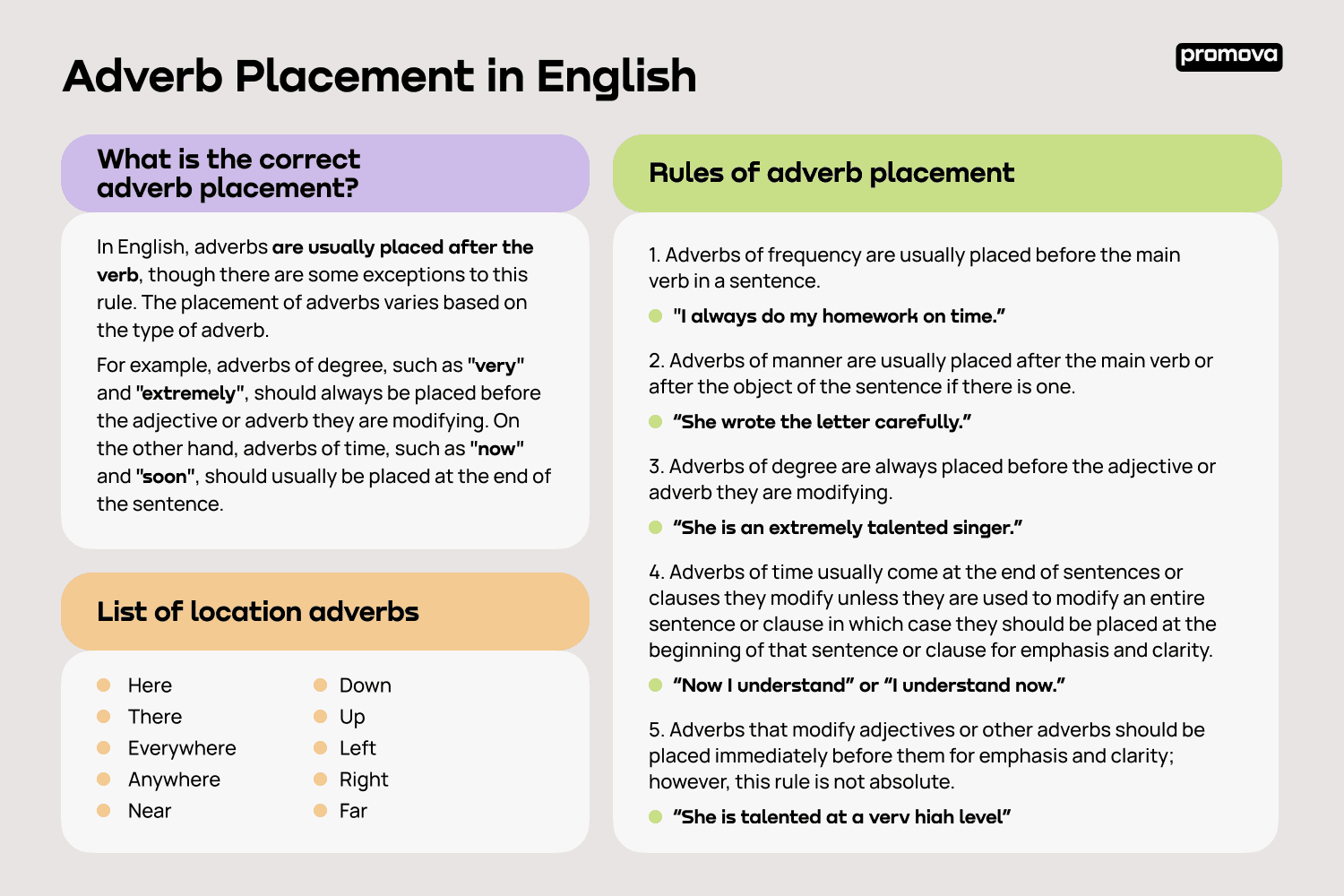Adverb Placement in English
Contents
Adverbs are a great way to add color and depth to your writing. But, have you ever wondered about the correct adverb placement? If you're looking for the answer, you've come to the right place! In this reference, we'll explore the nuances of adverb placement, and provide you with some useful tips and tricks to get it right every time.
What is the Correct Adverb Placement?
Adverbs are words that modify or describe a verb, an adjective, another adverb, or a clause. In English, adverbs are usually placed after the verb, though there are some exceptions to this rule. The correct placement of adverbs can help your writing flow better and convey the intended meaning more effectively.
It's important to note that the placement of adverbs varies based on the type of adverb. For example, adverbs of degree, such as "very" and "extremely," should always be placed before the adjective or adverb they are modifying. On the other hand, adverbs of time, such as "now" and "soon," should usually be placed at the end of the sentence.
Rules of adverb placement
1. Adverbs of frequency (e.g. always, never, often) are usually placed before the main verb in a sentence.
"I always do my homework on time.”
2. Adverbs of manner (e.g. quickly, slowly, carefully) are usually placed after the main verb or after the object of the sentence if there is one.
“She wrote the letter carefully” or “She carefully wrote the letter.”
3. Adverbs of degree (e.g. very, extremely) are always placed before the adjective or adverb they are modifying.
“She is an extremely talented singer.”
4. Adverbs of time (e.g., now, soon) usually come at the end of sentences or clauses they modify unless they are used to modify an entire sentence or clause in which case they should be placed at the beginning of that sentence or clause for emphasis and clarity.
“Now I understand” or “I understand now.”
5. Adverbs that modify adjectives or other adverbs should be placed immediately before them for emphasis and clarity; however, this rule is not absolute as there may be cases where it makes more sense to place the adverb elsewhere in the sentence.
“She is very talented” is simple, but in a sentence like “She is talented at a very high level” it is more effective to place the adverb “very” before the adverb “high.”
Position of Adverbs in Sentences - Examples
Let's explore a few examples of adverb placement in sentences.
“She quickly finished the task.”
In this sentence, the adverb "quickly" modifies the verb "finished." Therefore, it should be placed after the verb.
“He ran extremely fast.”
In this sentence, the adverb "extremely" modifies the adjective "fast." Therefore, it should be placed before the adjective.
“She always arrives early.”
In this sentence, the adverb "always" modifies the verb "arrives." Therefore, it should be placed after the verb.
As you can see, the placement of adverbs can be tricky, but it's important to get it right to ensure that your writing is correct and clear.
8
List of Location Adverbs
Adverbs of location, such as "here" and "there," refer to the location or direction of an action. Here is a list of commonly used location adverbs:
- Here
- There
- Everywhere
- Anywhere
- Down
- Up
- Left
- Right
- Near
- Far
- Within
Location adverbs should usually be placed at the end of the sentence. However, if the sentence contains two or more location adverbs, they should be placed in the middle of the sentence.
Creating Sentences with Adverbs
Now that you know the rules for adverb placement, let's look at how to create sentences with adverbs.
One way to create sentences with adverbs is to start with the verb. For example, to create a sentence with the adverb "quickly," you can start by writing "She quickly ____." Then, you can add a verb to complete the sentence.
Another way to create sentences with adverbs is to use adverbs to describe something. For example, you can use the adverb "beautifully" to describe a sunset. You can write the sentence “The sunset was beautifully orange.”
Adverbs help make your writing more descriptive and engaging, so don't shy away from adding as many to your English vocabulary as you can!
Common Adverb Placement Mistakes
One of the most common mistakes learners make when it comes to adverb placement is placing adverbs at the beginning of the sentence. For example, "Quickly she finished the task." This sentence is incorrect because the adverb should be placed after the verb.
Another common mistake is placing the adverb before an adjective or adverb it doesn't modify. For example, "She quickly finished the very task." In this sentence, "very" is an adverb, so the adverb "quickly" should not be placed before it.
It's also important to remember that an adverb of frequency, such as "always" and "never," should usually be placed at the beginning or end of the sentence.
Lastly, don't overuse your adverbs. Too many adverbs can make your writing sound redundant and repetitive. For example, “The sunset was beautifully, brilliantly, and stunningly orange.”
Correctly written, the sentence "The sunset was beautifully orange" conveys a vivid image already.

Summary
Adverbs are words that modify or describe a verb, an adjective, another adverb, or a clause. In English, the placement of adverbs varies based on the type of adverb. Adverbs of degree should be placed before the adjective or adverb they are modifying, while adverbs of time should usually be placed at the end of the sentence. Adverbs of location should usually be placed at the end of the sentence, and adverbs of frequency should usually be placed at the beginning or end of the sentence.
It's important to remember these rules when writing, as incorrect adverb placement can lead to confusion. With practice and some helpful tips, you'll be able to use adverbs to add color and depth to your own English!
Comments